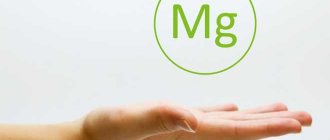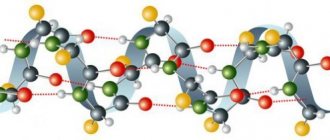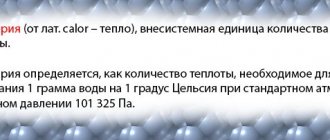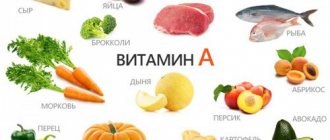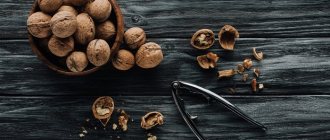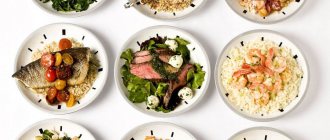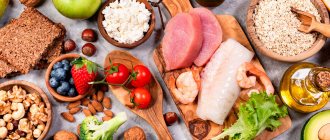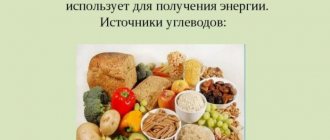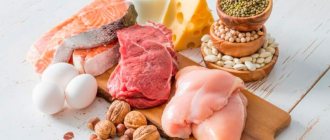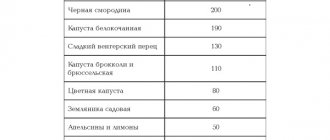In this article we will tell you:
- The role of vitamin B12
- Metabolism of vitamin B12 in the human body
- Foods rich in vitamin B12
- Deficiency Symptoms
- Risk factors for vitamin B12 deficiency
- Deficiency diagnosis
- Summary of Laboratory Tests to Assess Vitamin B12 Deficiency
- Recommended daily dose of vitamin B12
- How to compensate for vitamin B12 deficiency
One of the most important nutrients for the human body is cobalamin, known as vitamin B12. Until recently, it was mentioned only briefly and only in the context of the health of the nervous system. Subsequent discoveries made it possible to boldly declare: the role of vitamin B12 was greatly devalued. The formation of blood cells, regulation of gene function, prevention of cardiovascular diseases and even a protective effect against coronavirus infection - the use of cobalamin should definitely not be limited to the practice of neurologists.
The role of vitamin B12
Cofactor function
The wide range of effects exerted by vitamin B12 is associated with its cofactor function - it acts as a helper molecule for two different enzymes. The first of them, methionine synthase, neutralizes the amino acid homocysteine, the accumulation of which is recognized as an important risk factor for cardiovascular diseases: atherosclerosis, stroke and thrombosis. In addition, the same enzyme contributes to the formation of building blocks in the DNA molecule; neutralization of histamine (inflammatory mediator) and sex hormones; supports the exchange of serotonin, dopamine and other neurotransmitters; regulates the functioning of genes.
The second enzyme, whose work directly depends on vitamin B12, is involved in the neutralization of toxic methylmalonic acid, which damages the outer membrane of the nerves and thereby disrupts the conduction of nerve impulses.
Support mental health and cognitive function
Today it is reliably known that homocysteine affects not only the functioning of the cardiovascular system, but also the conductor of the whole organism - the brain.
Nerve cells are extremely vulnerable to damage due to the brain's high oxygen consumption, significant concentrations of iron and lipids that can be oxidized, and relatively low antioxidant activity. In other words, it is a kind of powder keg, and homocysteine is the lit match, causing a powerful explosion and subsequent fire in the form of oxidative stress, leading to cognitive impairment, dementia and behavioral disorders.
Study
: Vitamin B12 and health
Hematopoiesis
In the red bone marrow, the factory for the formation of blood cells, vitamin B12 activates the division of red blood cell precursors. Under conditions of its deficiency, they continue to grow, but do not divide—giant immature red blood cells—megaloblasts—are formed.
Prevention of osteoporosis
A number of researchers have proposed considering the accumulation of homocysteine in the body as a new risk factor for osteoporosis.
Osteoporosis
is a skeletal disease characterized by impairment of bone mineral density, structure, and strength, leading to an increased risk of fractures.
Study
: Hyperhomocysteinemia is Associated with Inflammation, Bone Resorption, Vitamin B12 and Folate Deficiency and MTHFR C677T Polymorphism in Postmenopausal Women with Decreased Bone Mineral Density
High homocysteine levels (in the setting of B vitamin deficiency - especially B9 and B12) have been noted to increase the risk of fractures, but have little effect on bone mineral density. Presumably, this is due to the accumulation of this amino acid in the bones and its binding to collagen, one of the main proteins of bone tissue.
Study
: The role of hyperhomocysteinemia as well as folate, vitamin B(6) and B(12) deficiencies in osteoporosis: a systematic review
Sources, role and symptoms of hypovitaminosis
B vitamins include: B1, B2, B3, B5, B6, B7, B9, B12. Previously, these included compounds B4 (choline), B8 (inositol). Levocarnitine has also been mistakenly called vitamin B11.
Vitamin B1 - thiamine
Takes part in the metabolism of carbohydrates and a number of amino acids, is important for the nervous, cardiovascular systems, and liver cells. Vitamin B1 is not synthesized in the body; it requires regular intake from food to meet its needs. They are rich in wheat sprouts, rye bread, various seeds and nuts, brown rice, legumes, and sea buckthorn berries. Animal sources include pork, chicken, salmon, and eggs.
Symptoms of vitamin B1 deficiency develop during fasting, unbalanced diet and manifest themselves in the form of severe neurological disorders (beriberi disease):
- pain in the calf muscles;
- decreased deep and cutaneous sensitivity of the legs and feet;
- paresthesia in the legs (tingling, goosebumps);
- sleep disturbances, emotional instability;
- decreased memory and mental performance.
In patients with anorexia and alcoholism, symptoms of B1 deficiency (acute Gaye-Wernicke encephalopathy, Korsakoff syndrome) can develop acutely. The clinic shows severe motor disturbances, visual disturbances, confusion, and psychotic symptoms. Without emergency help, a person can die within a few days.
Vitamin B2 - riboflavin
This is a source for creating enzymes that participate in the synthesis of vitamin B6 derivatives, reactions with acids, break down foreign and dangerous compounds, and are responsible for the state of hemoglobin in the body.
So it is necessary for:
- maintaining healthy skin, hair nails;
- formation of red blood cells and antibody proteins;
- regulation of reproductive function.
The main sources of B2 are food of animal origin - kidneys, liver, eggs. It is found in smaller quantities in porcini mushrooms and champignons, broccoli, almonds and cottage cheese.
Anorexia, vegetarianism, inflammatory diseases of the gastrointestinal tract, alcoholism, taking sulfur preparations or tranquilizers can provoke hypovitaminosis B2.
Its clinical manifestations are as follows:
- angular stomatitis (“jams”, ulcers in the corners of the mouth);
- dryness and cracks in the mucous membranes of the lips;
- glossitis (swelling, redness of the tongue);
- conjunctivitis or keratitis (red eyes, photophobia, decreased vision);
- dermatitis on the skin of the face (eyelids, nasolabial folds, ears, nose);
- weakness, fatigue, drowsiness;
- muscle pain and muscle weakness;
- anemia.
B3 - niacin
Other well-known names for the vitamin include nicotinic acid and vitamin PP. The substance takes part in cell division, protein synthesis, hormones, cellular respiration and many other processes. With the participation of this vitamin, steroid hormones and fatty acids are formed. In addition, B3 has a vasodilating effect, heals wounds, and reduces the concentration of cholesterol in the blood (primarily “dangerous” fractions).
The source of the vitamin is the essential amino acid tryptophan. Rich foods include: liver, tuna, turkey, brewer's yeast. You can also get B3 by adding whole grains to your diet: oats, rye, barley, wheat germ, peanuts.
Heat treatment reduces the vitamin content in food, and love for refined carbohydrates increases the need for it.
The unusual name “vitamin PP” is an abbreviation of two English words “preventive pellagra”, which means “preventing pellagra”. Signs of deficiency are described as a disease of the “three Ds”: diarrhea, dermatitis, dementia. They occur with prolonged hypovitaminosis. Clinical manifestations are more extensive and include:
- dermatitis, increased skin sensitivity to sunlight, baldness;
- walking impairment, neuritis, paralysis of limbs;
- weakness and fatigue, headaches;
- from the psyche: asthenia, sleep disturbances, aggression, dementia;
- heart damage - dilated cardiomyopathy.
Vitamin B5 - pantothenic acid
The biologically active substance is involved in the metabolism of proteins, fats and carbohydrates. It stimulates the adrenal cortex to increase the secretion of corticosteroids. The vitamin is involved in the synthesis of antibodies, normalizes lipid metabolism, and restores the integrity of the skin and mucous membranes.
A smaller part of B5 enters the body with food: egg yolk, yeast, milk, carrots, caviar, green salads. The main amount of the vitamin is synthesized by intestinal flora. This fact explains the occurrence of its deficiency against the background of long-term use of antibacterial or synthetic sulfonamide drugs and malabsorption syndrome. in which the absorption of substances is impaired.
Hypovitaminosis manifests itself in the form of metabolic disorders, damage to the digestive tract, skin and nail diseases, and weakened immunity.
Patients usually complain of:
- fatigue, headaches;
- deterioration of skin condition;
- low mood;
- muscle pain;
- numbness and pain in the feet;
- nausea, digestive disorders;
- frequent viral infections.
Vitamin B6 – pyridoxine
Participates in the formation of red blood cells and the hemoglobin they contain. Being a coenzyme of proteins that process amino acids (primarily in the nervous system) it helps cells properly utilize and consume glucose, preventing sudden surges in blood sugar. The effect on the body is to maintain physical and mental performance, ensuring trophic innervation of the nervous system.
Therefore, deficiency primarily manifests itself in the form of symptoms such as:
- depression, lethargy;
- decreased resistance to any load;
- numbness, paresthesia in the arms and legs;
- joint pain, arthritis;
- muscle weakness;
- “jams” in the corners of the mouth, hair loss.
Hypovitaminosis occurs against the background of an unbalanced diet (diet, alcoholism), taking the B6 antagonist drug ftivazid. An increase in the need for B6 is possible during antibiotic treatment, smoking, and hormonal contraceptive therapy.
Pyridoxine is found in green plants, nuts, tomatoes, strawberries, lemons, oranges, and legumes. Animal sources include eggs, liver, fish.
Hypervitaminosis occurs due to the consumption of large doses of B6 and is characterized by a decrease in protein concentration in tissues: weakness, confusion, convulsions. Scientists have proven that an overdose of this vitamin increases the risk of developing lung cancer in men.
Vitamin B7 - Biotin
Regulates all types of metabolism, participates in the synthesis of the structural protein collagen, and the transfer of carbon dioxide molecules. Contained in egg yolks, beef liver, bananas, brown rice, citrus fruits, apples, parsley. Most of the vitamin is synthesized by intestinal flora.
Biotin deficiency develops against the background of strict diets, taking antibiotics, using preservatives E221-E228, and alcoholism.
Signs of deficiency will be:
- anemia;
- dryness, flaking of the skin;
- dermatitis in the corners of the mouth;
- anorexia, nausea;
- weakness, apathy, increased drowsiness;
- high levels of fat and glucose in the blood.
Hereditary diseases associated with impaired vitamin metabolism are also possible. They manifest in the neonatal period or in older children. Among the alarming symptoms are seizures, delayed physical and mental development.
Vitamin B9 - folic acid
Responsible for cell growth and maintaining DNA integrity. The vitamin has an effect on the development of the nervous system and is involved in hematopoiesis. Folic acid enters the body with food and is synthesized by bacteria in the intestines. Sources of B9 - spinach, asparagus, broccoli, pork and chicken liver, legumes.
Vitamin deficiency is most dangerous during pregnancy, as there is a risk of miscarriage and deformities in the fetus. The risk group includes:
- women with folate metabolism disorders, when B9 is less absorbed by the body;
- pregnant women receiving treatment with valproic acid (anticonvulsant) drugs.
But hypovitaminosis is dangerous not only for special categories of people. An increased need for B9 occurs during therapy with anti-malaria drugs and cytostatics (Fansidar, Methotrexate).
You can suspect a vitamin deficiency if you have the following symptoms:
- infertility in men and women;
- early miscarriages;
- fetal development abnormalities;
- decreased mental performance;
- megaloblastic anemia (by blood test).
Substance B10 or para-aminobenzoic acid is a fragment of vitamin B9; its properties have not been fully studied, and there are no clinical studies on the need for prophylactic use.
Vitamin B12 - cyanocobalamin
It is absorbed and works only when taken with animal food or as part of medications in the small intestine. Cyanocobalamin is also produced by bacteria in the large intestine, but the body cannot absorb it.
The substance participates in the oxidation reactions of proteins and fats. Food sources of cyanocobalamin are pork, beef liver, herring, mackerel, eggs, cheese, cottage cheese.
A complete rejection of animal products that contain the vitamin leads vegans to the development of megaloblastic anemia. The following also suffer from vitamin deficiency:
- patients with diseases of the ileum, helminthiases (absorption is impaired);
- persons with Castle factor deficiency (produced in the stomach and activates B12).
Hypovitaminosis is associated not only with pathologies of hematopoiesis, but also with the destruction of the myelin sheaths of nerve fibers, and depressive syndrome in the elderly.
Metabolism of vitamin B12 in the human body
Cobalamin metabolism is complex - a healthy body absorbs no more than 50% of the vitamin supplied with food.
Study
: Vitamin B12 sources and bioavailability
Moreover, not only the content, but also the bioavailability (i.e., the ability to be absorbed) of vitamin B12 varies quite widely depending on the type of product and even the type of meat:
| type of product | Bioavailability |
| Fish | 42% |
| Mutton | 56%-89% |
| Chicken | 61%-66% |
| Eggs | <9% |
Cobalamin found in food is tightly bound to proteins, so hydrochloric acid and gastric juice enzymes are critical for the release of vitamin B12. Free cobalamin in the stomach forms complexes with other protein molecules (glycoproteins) and moves to the initial part of the small intestine - the duodenum. Here, under the action of enzymes in pancreatic juice, the complexes are destroyed, and vitamin B12 binds to the intrinsic Castle factor, a protein that ensures the absorption of B12 in the intestine.
Cobalamin is the only water-soluble vitamin that accumulates in the human body: from 50 to 90% of its reserves are concentrated in the liver. The presence of vitamin B12 reserves causes the later appearance of clinical symptoms of deficiency: they often appear only after several years.
Study
: The Neuropsychiatry of Vitamin B12 Deficiency in Elderly Patients
Thus, maintaining adequate levels of vitamin B12 in the body depends on a number of factors
:
- normal secretion of gastric juice;
- enzymatic function of the pancreas;
- functional state of the liver and intestines;
- contractile activity of the gallbladder.
We recommend
“What to eat for breakfast with proper nutrition: ideas for healthy breakfasts for the whole family” Read more
The main benefits and functions of vitamin B for the body
The main function of B vitamins is to ensure normal lipid, fat and carbohydrate metabolism, release energy, and normalize the functioning of the nervous system. These elements are water-soluble substances, so a person needs to regularly replenish their reserves with food.
What are the benefits of vitamin B:
- converts carbohydrates into glucose, which ensures normal performance and prevents malfunctions in the nervous system;
- responsible for the normal condition of the skin, hair, nails, mucous membranes, bones and joints;
- supports the normal functioning of the digestive organs, heart, blood vessels, brain;
- participates in the production of hormones, red blood cells, cell division;
- strengthens the immune system, reduces the risk of malignant tumors, protects the body from the negative effects of external factors.
Vitamin B is found in many common foods - cereals, seasonal vegetables and fruits, bread, grains, dairy products, liver, eggs.
However, this substance is quickly destroyed under the influence of high temperatures, long-term storage, and their quantity is significantly reduced by soaking, industrial processing, and grinding. Vitamin B deficiency leads to the development of dermatological and cardiac pathologies, bones become brittle, the skin and mucous membranes dry out, memory and reproductive functions deteriorate. A balanced diet and proper processing of foods will help replenish these elements daily.
Foods rich in vitamin B12
When calculating daily intake, it is necessary to take into account the bioavailability of B 12 from specific products (see above).
| Products | Vitamin B12 content per 100 g of product |
| Shellfish | 98.9 mcg |
| Beef liver (raw) | 59.3 mcg |
| Goose liver | 54.0 mcg |
| Octopus | 36.0 mcg |
| Turkey liver | 28.2 mcg |
| Pork liver | 26.0 mcg |
| Chicken liver (raw) | 16.6 mcg |
| Herring | 13.7 mcg |
| Mussels | 12.0 mcg |
| Mackerel | 8.7 mcg |
| Trout | 7.8 mcg |
| Chicken hearts | 7.3 mcg |
| Rabbit meat | 7.2 mcg |
| Chicken egg yolk | 5.1 mcg |
Vitamin B1 (thiamine)
Promotes the conversion of carbohydrates, fats and proteins into energy.
- look like small transparent crystals.
- does not dissolve in alcohol,
- cannot be stored in reserve in human organs and tissues and
- does not cause a toxic effect.
- Our body can produce vitamin B1 on its own thanks to special bacteria in the colon.
What are the benefits of vitamin B1?
- regulates the normal functioning of the nervous system
- needed for the formation of acetylcholine
- participates in the exchange of water and salt, proteins, fats
- participates in the process of carbohydrate metabolism, the interaction of pyruvic and lactic acids
- is formed in the body as a phosphorylated form of vitamin B1
- responsible for hematopoiesis, improves blood transport to organs
- has a positive effect on the functioning of the brain and its abilities: increases the ability to learn, affects the cognitive functions of the brain
- has a positive effect on growth and energy levels.
- increases appetite
- good for the heart muscles and gastrointestinal tract.
- powerful antioxidant, prevents premature aging
- eliminates partially the toxic effects of alcoholic beverages and tobacco on the body
- products consumed in one meal along with thiamine are much better absorbed
Vitamin B1 intake rate
Average daily intake of vitamin B1:
- from 0 to 1 year - 0.4 mg
- from 1 to 3 years - 0.8 mg.
- from 4 to 6 years - 0.9 mg,
- from 7 to 10 years - 1.2 mg
- For men over 11 years of age, 1.2 to 1.5 mg is recommended. 1.5 mg should be taken in old age or if you have bad habits
- Women over 11 years of age are recommended from 1 to 1.3 mg of thiamine per day. Pregnant women – 1.5 mg. Breastfeeding - 1.6 mg per day.
A few rules:
- The older a person gets, the more thiamine he needs, since with age it begins to be absorbed worse and worse.
- If a child eats incorrectly and is not balanced, then the dose of thiamine should be increased. Especially if the child eats a lot of foods containing flour.
What foods contain vitamin B1?
Thiamine is found in both plant and animal products, but after heat treatment, thiamine breaks down and is found in food in minute quantities. The leader in the amount of vitamin B1 are sunflower seeds. But it won’t be in regular store-bought oil, because during production at factories the oil goes through many treatments, including heat. Only natural, cold-pressed sunflower oil will be beneficial.
Foods rich in vitamin B 1
| The product's name | Vitamin B1 content per 100g, mg |
| Sunflower seeds sunflower seeds | 1,84 |
| Sesame | 1,27 |
| Oat bran | 1,17 |
| Soybean grain | 0,94 |
| Peas | 0,9 |
| Pistachios | 0,87 |
| Sunflower halva | 0,8 |
| Wheat bran | 0,75 |
| Peanut | 0,74 |
| Pollock caviar | 0,67 |
| Red granular caviar | 0,55 |
| Meat pork meat | 0,52 |
| Cashew | 0,5 |
| Bean grain | 0,5 |
| Lentil grain | 0,5 |
| Oatmeal | 0,49 |
| Oats grain | 0,47 |
| Hazelnut | 0,46 |
| Oat flakes "Hercules" | 0,45 |
| Wheat grain, soft variety | 0,44 |
| Rye grain | 0,44 |
| Buckwheat groats | 0,43 |
| Buckwheat | 0,42 |
| Millet groats, polished | 0,42 |
| Rye wallpaper flour | 0,42 |
| Wheat flour | 0,41 |
| Pine nut | 0,4 |
| Buckwheat flour | 0,4 |
| Fat pork meat | 0,4 |
| Walnut | 0,39 |
| Beef kidneys | 0,39 |
| Durian | 0,37 |
| Wheat flour 2 grades | 0,37 |
| Wheat grain, durum | 0,37 |
| Corn flour | 0,35 |
| Oat flour | 0,35 |
| Peeled rye flour | 0,35 |
| Insect Protein IPC | 0,34 |
| Fresh green peas | 0,34 |
| Rice grain | 0,34 |
| Chum salmon | 0,33 |
| Barley grain | 0,33 |
| Buckwheat grain | 0,3 |
| Wheat groats | 0,3 |
| Low-fat dry milk | 0,3 |
| Beef liver | 0,3 |
| Tuna | 0,28 |
| Barley groats | 0,27 |
| Powdered milk 25% | 0,27 |
| Insect meal WBP | 0,26 |
| Pasta made from 1st grade flour | 0,25 |
| Almond | 0,25 |
| Wheat flour 1st grade | 0,25 |
| Dry cream 42% | 0,25 |
| Egg powder | 0,25 |
| Dried white mushrooms | 0,24 |
| Chicken egg yolk | 0,24 |
| Powdered milk 15% | 0,24 |
| Atlantic salmon | 0,23 |
| Navaga | 0,23 |
| Oatmeal flour | 0,22 |
| Pink salmon | 0,2 |
| Sweet corn | 0,2 |
| Dandelion leaves greens | 0,19 |
| Som | 0,19 |
| Sorrel greens | 0,19 |
| Squid | 0,18 |
| Premium flour pasta | 0,17 |
| Premium wheat flour | 0,17 |
| Seeded rye flour | 0,17 |
| Horse mackerel | 0,17 |
| Insect fiber FP | 0,16 |
| Dried acorns | 0,15 |
| Raisin | 0,15 |
| Crayfish | 0,15 |
| Chees Feta" | 0,15 |
| Oyster | 0,15 |
Deficiency Symptoms
Typically, manifestations of vitamin B12 deficiency manifest with general anemic syndrome, which is characterized by
:
- yellowish tint to the skin or pallor;
- dyspnea;
- dizziness;
- cardiopalmus.
In addition, manifestations accompanying cobalamin deficiency are
:
- hair loss;
- bowel dysfunction (diarrhea);
- lack of appetite;
- muscle weakness and decreased muscle tone;
- pigmentation;
- an increase in the size of the liver and spleen on ultrasound;
- “varnished” tongue (atrophy of taste buds);
- lack of motivation and energy.
Disorders of the nervous system deserve special attention. Neurological symptoms are later (although in some cases they precede the development of anemia) and, as a rule, are irreversible. Damage to the genetic material of cells, increased excitability of neurons and disruption of electrolyte metabolism in them, inhibition of the formation of new nerve connections - all these consequences of insufficient intake of vitamin B12 in the body underlie the development of dementia - including Alzheimer's disease. A growing body of research also points to a direct link between cobalamin deficiency and the development of depression.
Study
: Effects of vitamin B12 and folate deficiency on brain development in children
Vitamin B12 deficiency has a particularly acute effect on newborns and young children: as is known, brain development begins in utero and continues until school age. Cobalamin deficiency leads to impaired myelination of nerve fibers and changes in the speed of impulses, thereby having a significant impact on the functioning of the central nervous system. As a result, slower conduction in the auditory and visual systems will interfere with learning and social interaction.
Vitamin B12 (cyanocobalamin)
Promotes the formation of red blood cells; growth and activity of the nervous system. Vitamin B12 is not synthesized in the human body and enters the body with food of animal origin. Plant foods contain virtually no vitamin B12.
Foods rich in vitamin B 12
| The product's name | B12 content per 100g, mcg |
| Insect Protein IPC | 5300 |
| Insect meal WBP | 800 |
| Insect fiber FP | 400 |
| Insect tofu TIP | 300 |
| Beef (or veal) and lamb liver (cooked) | 79 |
| Lamb kidneys (cooked) | 78,9 |
| Veal kidneys (cooked) | 36,9 |
| Oysters | 26 |
| Beef kidneys (cooked) | 24,9 |
| Chicken, turkey, or pork liver (cooked) | 24 |
| Mussels | 24 |
| Bivalves, excluding oysters and mussels | 19,4 |
| Atlantic herring (smoked) | 18,6 |
| Mackerel (cooked) | 18,5 |
| Turkey giblets (cooked) | 16 |
| Caviar (raw) | 12 |
| Regular tuna (raw or cooked) | 11,5 |
| Kamchatka crab (cooked) | 11,4 |
| Sardines (canned in oil or tomato sauce) | 9 |
| Goose or chicken liver pate | 8,8 |
| Caviar black or red | 8 |
| Sockeye salmon (cooked) | 5,8 |
| Trout (cooked) | 5,7 |
| Pink salmon (canned with bones) | 4,9 |
| Ground beef (cooked) | 3,4 |
| Swiss Emmental cheese | 3,4 |
| Atlantic salmon, wild (cooked) | 3 |
| Tuna (grayish-pink, canned in water) | 2,9 |
| Various beef trimmings (cooked) | 2,5 |
| Beef or pork salami | 2 |
| Cheeses: feta, gouda, edam, gruyere, brie, cheddar, fontina, mozzarella, provolone | 1,6 |
| Bacon strips (cooked) | 1,5 |
| Pork pate (cooked) | 1,1 |
| Sausages | 1 |
| Ham (cooked) | 0,9 |
| Various pork trimmings (cooked) | 0,9 |
| Slices of processed cheddar cheese | 0,8 |
| Chicken, turkey or duck (cooked) | 0,3 |
Risk factors for vitamin B12 deficiency
Reduced intake of vitamin B12 from food
- vegetarian diet;
- chronic alcoholism;
- old age.
An unbalanced vegetarian diet may be associated with a lack of nutrients, the content and/or bioavailability of which in plant foods is low (this applies to iron, zinc, vitamin D, omega-3 fatty acids and vitamin B12).
In older people, vitamin B12 deficiency is often caused by
:
- malnutrition;
- malabsorption syndrome;
- inflammation of the gastric mucosa (which increases with age) and leads to a decrease (and sometimes complete cessation) of the secretion of hydrochloric acid, necessary for the release of protein-bound vitamin B12.
Autoimmune thyroid diseases
According to research, vitamin B12 deficiency occurs in 46% of patients with autoimmune thyroiditis. In addition, there is a negative correlation between the levels of vitamin B12 and antibodies to the structural elements of the thyroid gland. It is assumed that this connection is due to the presence of autoimmune gastritis: as is known, autoimmune diseases are often combined.
Study
: Vitamin B12 and Vitamin D Levels in Patients with Autoimmune Hypothyroidism and Their Correlation with Anti-Thyroid Peroxidase Antibodies
Increased need for cobalamin
It has been established that during pregnancy and lactation the need for cobalamin increases several times, and its content progressively decreases.
We recommend
“The benefits of grapes: vitamin content, calorie content and recommendations for consumption” Read more
Condition of the human digestive system
The status of vitamin B12 is largely determined not only by a balanced diet, but also by the state of the human digestive system and the presence of all the conditions necessary for its absorption. Various factors and pathological processes disrupt the release and absorption of B12, contributing to the development of its deficiency.
Study
: Modern possibilities for diagnosing and treating vitamin B12 deficiency
| Cause | Pathological condition |
| Violation of the secretion of gastric juice or changes in its acidity: |
|
| Intestinal malabsorption: |
|
Taking a number of medications
- metformin;
- antacids;
- H2 blockers;
- proton pump inhibitors;
- colchicine;
- cholestyramine;
- anticonvulsants and a number of antibiotics.
A number of genetic disorders
- transcobalamin II deficiency;
- intrinsic factor Castle deficiency/defect;
- mutation in the CG1 gene.
Targeted nutrition tips
that will increase your energy level by 10 out of 10
From TOP nutritionists of the MIIN
Get tips
Vitamin B5 (pantothenic acid)
Participates in the synthesis of antibodies, accelerates wound healing.
- required for the metabolism of fats, carbohydrates, amino acids
- participates in the synthesis of vital fatty acids, cholesterol, histamine, acetylcholine, hemoglobin
- stimulates the production of adrenal hormones - glucocorticoids, which makes it a powerful remedy for the treatment of diseases such as arthritis, colitis, allergies and heart disease
- produced in significant quantities by intestinal flora
- reserves of pantothenic acid in the body last for 2–4 weeks
The recommended intake of vitamin B5 is 5 mg/day
. Important:
- Vitamin B5 absorption is impaired by excessive coffee and alcohol consumption
- food processing reduces the vitamin content by 30–50%
A lack of pantothenic acid affects the functioning of all body systems, especially the nervous, muscular, gastrointestinal tract, excretory system and skin.
Foods rich in vitamin B 5
| The product's name | Vitamin B5 content per 100g, mg |
| Insect Protein IPC | 6,48 |
| Insect meal WBP | 4,11 |
| Chicken egg yolk | 4 |
| Egg powder | 4 |
| Low-fat dry milk | 3,32 |
| Powdered milk 25% | 2,7 |
| Insect fiber FP | 2,55 |
| Peas | 2,3 |
| Wheat bran | 2,18 |
| Peanut | 1,77 |
| Soybean grain | 1,75 |
| Atlantic salmon | 1,6 |
| Oat bran | 1,5 |
| Avocado | 1,4 |
| Chicken egg | 1,3 |
| Wheat grain, durum | 1,2 |
| Bean grain | 1,2 |
| Lentil grain | 1,2 |
| Cheese "Roquefort" 50% | 1,16 |
| Hazelnut | 1,15 |
| Sunflower seeds sunflower seeds | 1,13 |
| Wheat grain, soft variety | 1,1 |
| Camembert cheese | 1,1 |
| Chum salmon | 1 |
| Wheat groats | 1 |
| Oats grain | 1 |
| Rye grain | 1 |
| Dried acorns | 0,94 |
| Cauliflower | 0,9 |
| Oatmeal | 0,9 |
| Wheat flour | 0,9 |
| Fatty herring | 0,85 |
| Mackerel | 0,85 |
| Walnut | 0,82 |
| Fresh green peas | 0,8 |
| Condensed milk with sugar 8.5% | 0,8 |
| Wheat flour 2 grades | 0,8 |
| Broiler chicken meat | 0,79 |
| Sweet corn | 0,76 |
| Chicken meat | 0,76 |
| Pink salmon | 0,75 |
| Barley grain | 0,7 |
| Turkey meat | 0,65 |
| Rice grain | 0,6 |
| Lean herring | 0,6 |
| Processed cheese "Russian" | 0,6 |
| Garlic | 0,6 |
| Cilantro greens | 0,57 |
| Lamb meat | 0,55 |
| Pistachios | 0,52 |
| Broccoli | 0,51 |
| Pearl barley | 0,5 |
| Wheat flour 1st grade | 0,5 |
| Beef meat | 0,5 |
| Meat pork meat | 0,47 |
| Parmesan cheese | 0,45 |
| Buckwheat flour | 0,44 |
| Prunes | 0,42 |
| Brussels sprouts | 0,4 |
| Rice groats | 0,4 |
| Curd mass 16.5% fat content | 0,4 |
| Almond | 0,4 |
| Dry cream 42% | 0,4 |
| Pumpkin | 0,4 |
| Milk 1.5% | 0,38 |
| Milk 2.5% | 0,38 |
| Milk 3.2% | 0,38 |
| Milk 3.5% | 0,38 |
| Yogurt 2.5% | 0,38 |
| Fat pork meat | 0,37 |
| Sea bass | 0,36 |
| River perch | 0,36 |
| Acidophilus 1% | 0,35 |
| Acidophilus 3.2% | 0,35 |
| Acidophilus 3.2% sweet | 0,35 |
| Acidophilus low-fat | 0,35 |
| Corn grits | 0,35 |
| Ice cream | 0,35 |
| Celery root | 0,35 |
| Cream 10% | 0,34 |
| Cream 25% | 0,34 |
| Cream 8% | 0,34 |
| Gouda cheese | 0,34 |
| Cheddar cheese 50% | 0,33 |
| Red cabbage | 0,32 |
| Kefir 1% | 0,32 |
| Kefir 2.5% | 0,32 |
| Kefir 3.2% | 0,32 |
| Low-fat kefir | 0,32 |
| Yogurt 1.5% | 0,31 |
| Yogurt 3.2% | 0,31 |
| Pine nut | 0,31 |
| Goat milk | 0,31 |
| Apricot | 0,3 |
| Potato | 0,3 |
| Pasta made from 1st grade flour | 0,3 |
| Premium flour pasta | 0,3 |
| Premium wheat flour | 0,3 |
| Cream 20% | 0,3 |
| Sour cream 10% | 0,3 |
| Sour cream 15% | 0,3 |
| Sour cream 20% | 0,3 |
| Sour cream 25% | 0,3 |
| Sour cream 30% | 0,3 |
| Cheese "Dutch" 45% | 0,3 |
| Swiss cheese 50% | 0,3 |
| Spinach greens | 0,3 |
Deficiency diagnosis
- Determining the level of vitamin B12 in the blood does not reflect the intracellular concentration of vitamin B12 and the performance of its biological function. Therefore, one can rely on laboratory determination of B12 in blood serum only to identify a significant deficiency.
- Laboratory reference: 189-833 pg/ml.
- Optimal values: from 600 and above.
- Cobalamin deficiency can be indirectly judged by the level homocysteine
(but it can also reflect a deficiency of folic acid and vitamin B2) - it is optimal that its values do not exceed 7 µmol/l.
- A fairly characteristic picture in a general blood test:
- increase (closer to the upper limit of the reference) MCV
- average volume of erythrocytes.
- The most sensitive marker of vitamin B12 deficiency is an increase in methylmalonic acid, a test for organic acids in urine.
However, it should be remembered that the concentration of methylmalonic acid often increases with kidney pathology. In addition, measuring its levels during concomitant use of antibiotics is not indicative (the number of bacteria that form methylmalonic acid precursors decreases).
Study
: The neuropsychiatry of vitamin B12 deficiency in elderly patients
Where and what does vitamin B 12 contain: a list of foods for every day
The benefits and role of vitamin-containing products for a healthy and beautiful body cannot be overestimated. Long silky hair, strong nails, smooth skin, a clear mind and excellent memory - all this provides us with excellent health and a great mood at any time of the year and even on the cloudiest day. A balanced and proper diet gives a surge of vitality and increases performance. A person who does not experience a deficiency of nutrients, compounds and vitamins is less likely to get sick during an exacerbation of colds. He is strong, full of energy and resilient to physical and mental stress, much less susceptible to stress and seasonal depression. In addition, including healthy compounds in your daily diet helps maintain body health, youth and beauty even in old age.
What should you include in your daily menu to prevent vitamin deficiency? To answer this question, we have compiled a list of the richest and most complete food sources of B12 for you.
Meat and offal
- Beef
- Beef liver
- Beef kidneys
- Beef tongue
- Beef heart
- Lean parts of pork
- Pork liver
- Mutton
- Game
- Chicken liver
- Rabbit
- Liverwurst
Chicken eggs, or more precisely, the yolks, also contain large amounts of B12.
Seafood
- Crab
- Octopus
- Shellfish
- Scallops
- Oysters
Fish
- Mackerel
- Perch
- Trout
- Chum salmon
- Sardine
- Herring
Dairy
- Cheese
- Milk
- Cottage cheese
- Kefir
- Sour cream
- Natural yogurt
- Curdled milk
Plant products
- Soya beans
- Green onions
- Salad leaves
- Spinach
It is important to remember that by limiting your intake of animal foods, the risk of developing B12 deficiency increases. In plant sources it is contained in small quantities and does not cover the daily requirement. Therefore, vegetarians should consult a specialist who will prescribe a course of necessary medications.
Author: Di&Di Corporation
Summary of Laboratory Tests to Assess Vitamin B12 Deficiency
| Laboratory test | Rationale for the test | Advantages | Flaws |
| Serum cobalamin | Decreased levels due to vitamin B12 deficiency | Available, low price. easy to interpret | Not reliable in assessing the effectiveness of the biological function of the vitamin |
| Methimalonic acid | Increased with vitamin B12 deficiency | High sensitivity | It is necessary to consider other factors affecting the metabolism of methylmalonic acid, high cost. |
| Total homocysteine | Increased with vitamin B12 deficiency | High sensitivity | Low specificity, increases under the influence of lifestyle factors (smoking, drinking alcohol, coffee). Requires assessment of genetic characteristics (methylation cycle). |
| Holotranscobalmin | Decreased in vitamin B12 deficiency New test, clinical utility unclear. | High sensitivity. | It can serve as an indicator of the supply of vitamin B 12, based on the amount of transport protein that carries the active form of B12. BUT: the active form of the vitamin is a very variable value. |
How to organize proper nutrition
Nutritionists recommend combining foods high in cyanocobalamin with vegetables and fruits rich in vitamin C. For example, freshly squeezed lemon juice can be poured over baked fish, and cranberry or lingonberry jelly can be served with meat. Black tea and coffee should be replaced with homemade berry juice or rosehip drink. The best cobalt-containing dessert is fresh strawberries, which can be eaten with milk or cream.
Those who do not eat meat or fish should focus on dairy products: low-fat cottage cheese, yogurt, milk.
Vitamin B 12 does not tolerate long-term cooking. It is better to steam or bake meat, liver, and fish. Those who love beef steaks should choose medium or medium doneness. The ideal option for a lack of cyanocobalamin is rare steak.
The simultaneous intake of folic acid and calcium will help improve the absorption of vitamin B 12.
The daily menu should include low-fat cottage cheese with sour cream, skim milk fortified with calcium, and natural cheese. Twice a week, meat or offal is introduced into the diet; at least once a week you should eat fatty fish, seafood or high-quality canned food in its own juice.
Recommended daily dose of vitamin B12
(after K. Astill-Smith and K. Reardon)
- 0-6 months: 0.4 mcg
- 7-12 months: 0.5 mcg
- 1-3 years: 0.9 mcg
- 4-8 years: 1.2 mcg
- 9-13 years: 1.8 mcg
- 14 years and older: 2.4 mcg
- Pregnancy: 2.6 mcg
- Breastfeeding: 2.8 mcg
Daily value of vitamin B12: 6 mcg
Daily values of B vitamins
When answering the question of how much B vitamins you need to get, you need to take into account the characteristics of your environment, gender, age, the presence of certain diseases, and increased physical or emotional stress on the body. The table below shows average standards.
| Vitamin name | Need for children | Requirement for adults/mg/day |
| B1 | 0,2-0,9 | 2 |
| B2 | 0,4-1,8 | 1,5-2 |
| B3 | 2-12 | 20 |
| B5 | 1-5 | 4-6 |
| B6 | 0,2-1 | 1,3 -2 |
| B7 | 5-20 | 30 |
| B9 | 0,05-0,15 | 0,2-0,26 |
| B12 | 0, 0004-0,0018 | 0,0025 |
B vitamins are classified as water-soluble compounds. This means that it is almost impossible to “eat your fill” with them. Substances are not stored in adipose tissue, but leave the body. The likelihood of hypervitaminosis against the background of a balanced diet is low.
Excess may also develop in response to long-term use of synthetic drugs. The main manifestations of hypervitaminosis include:
- hyperemia of the skin;
- allergic reactions;
- diarrhea, abdominal pain;
- sleep disorders;
- cramps in the muscles of the arms/legs;
- headache.
How to compensate for vitamin B12 deficiency?
The main task facing a nutritionist is to find and determine the cause that caused the cobalamin deficiency. So, in some cases, it is enough to review the diet and make appropriate adjustments to it: for example, increase the amount of animal products consumed.
If the problem is caused by a pathology in the digestive system, the work should be comprehensive: in collaboration with a gastroenterologist. The nutritionist offers recommendations for healing mucous membranes, improving the functioning of the digestive tract, normalizing stomach acidity to activate the Castle factor.
Gastrointestinal pathologies must be taken into account when selecting the method of administering cobalamin: for example, for lesions of the gastric mucosa, the sublingual (sublingual) form, which does not require the presence of hydrochloric acid, will be optimal. In addition, with concomitant infection with Helicobacter pylori, a nutritionist can recommend natural antimicrobial drugs or a combination of them: grapefruit seed extract, oregano, colloidal silver, etc.
If vitamin B12 deficiency has developed against the background of parasitosis, then the main link in the protocols should be aimed at restoring natural protective barriers and antimicrobial factors
:
- restoration of the integrity of mucous membranes;
- correction of the composition and outflow of bile;
- correction of impaired gastric acidity;
- maintaining the adrenal glands (without the hormones they produce, resolution of the inflammatory process is impossible).
Vitamin B12 supplements may be considered as maintenance therapy. Although the most active form is methyl-cobalamin, in some cases (for example, with the COMT++ mutation) it is recommended to take adenosylcobalamin or cyanocobalamin. In both cases, it is important to remember that cobalamin competes with many B vitamins, so it should be taken separately.
B12 overdose
Of course, you shouldn’t abuse this substance either. Moderation must be observed even in the most useful products and preparations. Uncontrolled use will only harm your body and certainly will not be beneficial. Hypervitaminosis – overdose, manifests itself in the following symptoms:
- Pain and stabbing on the left side of the chest, near the heart
- Increased excitability of the nervous system
- The number of heart beats per minute increases
An overdose of B12 will not bring serious, dangerous, or even fatal consequences, since this vitamin is water-soluble. Its excess easily leaves your body through urine. But still, this process requires a certain amount of time, and during this period hypervitaminosis can harm your body. Therefore, you should refrain from increased use of dietary supplements and vitamin complexes. If you buy the drug at the pharmacy, strictly follow the instructions and strictly observe the dosage. If you notice side effects, a deterioration in your general condition and well-being, temporarily stop using the complex and immediately consult a doctor. Do not resume the course until your specialist gives you permission.
What foods contain vitamin B2?
A vitamin that is responsible for a person’s appearance and health, which is determined by the condition of the skin, nails and hair. In order to have soft and smooth skin, beautiful hair and healthy nails, you should take care of a proper diet with foods rich in vitamin B2.
Riboflavin is an active substance that can support human health. The biological role of the substance is in the inclusion of its derivatives - coenzymes - in the content of many important enzymes.
The main functions of vitamin B2:
- strengthens the immune system;
- improves the metabolic process;
- helps in the absorption of iron, which is necessary for the formation of blood cells;
- responsible for the functioning of the thyroid gland;
- adds sharpness to vision and perception of color and light;
- keeps skin, hair and nails in good condition.
List of foods that contain the most vitamin B2
The first place in terms of maximum vitamin content is occupied by bread products and brewer's yeast.
The second is chicken heart and liver. There is some riboflavin in veal and chicken liver, but even this amount significantly exceeds the minimum daily dose. To preserve riboflavin in food, you do not need to defrost it. Frozen foods must be quickly placed in boiling water. Only if the meat was on the last shelf in the refrigerator did it not lose its beneficial qualities.
More interesting things
Okroshka with kefir sausage - a great recipe for a hot summer day
Nuts, especially almonds and peanuts, contain the highest amount of riboflavin. Their composition is also characterized by other useful substances. Nuts should be consumed regularly, preferably every day, in order to have good health.
Cereals also contain this substance, but in a smaller amount. Therefore, if your daily diet includes porridge made from buckwheat, rice and oatmeal, then there will be no shortage of vitamin B2 in the body.
Legumes, especially lentils, beans and peas, are real storehouses of nutrients. If you cook foods, more useful components will dissolve in water, so it is better to cover the dishes with a lid. In the worst case, beneficial substances are oxidized.
Vegetables contain riboflavin in small quantities. Temperature treatment promotes the destruction of the vitamin, which means it is healthier to eat vegetables raw. Fruits also contain some riboflavin, especially apricots. It is not recommended to leave vegetables and fruits in the sun for a long time. Direct exposure to sunlight provokes the loss of vitamin B.
The daily requirement is 2.5-3 mg.
| Products | Vitamin B2 mg/100g. |
| Baker's and brewer's yeast | 2,07-4 |
| Beef liver | 2,19 |
| Pork liver | 2,18 |
| Beef kidneys | 1,8 |
| Pork kidneys | 1,56 |
| Almond | 0,65 |
| Cheese | 0,5 |
| Egg | 0,44 |
| Cottage cheese | 0,3 |
| Veal | 0,23 |
| Soybeans | 0,22 |
| Lentils | 0,21 |
| Fish | 0,2 |
| Buckwheat | 0,2 |
| Rabbit | 0,18 |
| Beans | 0,18 |
| Beef | 0,17 |
| Pork | 0,16 |
| Chicken | 0,15 |
| Cow's milk | 0,15 |
| Peas | 0,15 |
| Walnuts | 0,13 |
| Oat groats | 0,11 |
| Whole grain wheat bread | 0,1 |
| Hazelnut | 0,1 |
| Rye bread | 0,08 |
| Rice | 0,04 |
Products containing vitamin B 1
Thiamine is a water-soluble unique trace element from the group of amino acids and an important component of the functioning of the body. Participates in all biochemical reactions of the body and its essential presence allows you to avoid many diseases.
Important functions of thiamine for the human body:
- stabilizes the metabolism of carbohydrates and fats in every tissue of a living organism;
- cleanses it by breaking down acids, which are poisonous to the nervous system;
- improves the metabolic process;
- promotes the process of hematopoiesis and improves blood circulation through the vessels;
- reduces cholesterol levels in the blood;
- optimizes brain function;
- helps improve immunity;
- actively participates in cellular metabolism, which helps rapid wound healing;
- prevents vision problems;
- normalizes the functioning of the stomach and intestines.
Table of valuable sources of vitamin B1
| Products | Vitamin B1 mg/100g |
| Brewer's yeast | 16,3-28,5 |
| Baker's yeast | 2,7-6,6 |
| Sunflower seeds | 1,95 |
| Sprouted wheat grains | 1,76 |
| Pine nuts | 1,24 |
| Peanut | 1,14 |
| Pork | 0,84 |
| Dry peas | 0,81 |
| Bran bread | 0,72 |
| Oatmeal | 0,6 |
| Buckwheat | 0,58 |
| Cashew | 0,5 |
| Lentils, beans | 0,5 |
| Unprocessed rice | 0,45 |
The daily intake of thiamine should be 1.3-2.6 mg. The amount of use should be increased for older people, nursing mothers, pregnant women, teenage children, as well as after taking antibiotics and under severe physical and psychological stress.
It is generally accepted that the best sources are peas, oatmeal, buckwheat, fatty pork and nuts.
Also no less important suppliers of thiamine are liver, bran and sprouted cereal grains, and sunflower fruits.
Beans and potatoes also contain thiamine, so the water after cooking should be used to prepare first courses or various sauces. Vitamin B1 is also present in baked goods made from wholemeal flour, rice, herbs, and nuts.
When choosing products with the maximum content of thiamine, it is necessary to take into account that this substance does not like high temperatures. Experts advise choosing products that do not require heat treatment.
How to preserve vitamin B in foods during cooking
It is known that beneficial nutrients are destroyed during long-term storage or during cooking. Fortunately, foods containing B vitamins are not susceptible to loss. They withstand temperature changes - from freezing to boiling and are slightly destroyed during cooking.
So B1 decomposes only at temperatures above 120 degrees, so it is not afraid of delicate heat treatment. B2 “does not like” storage in light and in transparent containers, therefore, for example, milk should not be stored for a long time in a glass container.
Other substances in this group are not afraid of cooking, but it is important to remember that when cooked they dissolve in the broth. Therefore, baked meat steak or baked fish will be more nutritious and valuable for the body than the same products, but boiled.
Let us remind you that the Public News Service previously told why hair quickly becomes oily in winter and how to fall asleep in 1 minute if you have insomnia.
